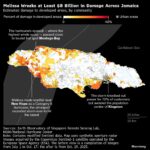Catastrophe modeling firm AIR Worldwide’s report on Windstorm Ulli notes that it is “passing through Scandinavia and is expected to dissipate as it moves over the Baltic Sea today.
“A class 2 weather warning from the Swedish Meteorological and Hydrological Institute (SMHI) is still in force indicating the possibility of ‘danger to the public, causing major damage to property and major disruptions in essential services.'”
Dr. Gerhard Zuba, senior principal scientist at AIR Worldwide, explained that “Ulli was first recognized as a named low pressure system when it was located southwest of Newfoundland on December 31st making it the last named storm of 2011. Ulli brought heavy precipitation and high winds across the UK and Europe and the system intensified significantly as it sped across the north Atlantic, eventually making landfall in Scotland with a central pressure of just 952mb.”
The storm dropped a lot of rain in Scotland, the Northern UK and Germany, causing officials to issue localized flood warnings.
According to AIR, Ulli’s “stronger than forecast winds have been blamed on the presence of a sting jet, a localized strong downdraft that can develop on the southern flank of an extra-tropical cyclone and bring cold, dry air from the mid-troposphere down to the surface.
“Sting jets generally cause intense, localized wind speeds, and this development may be responsible for the high gust speeds (of 106 mph [170 km/h]) recorded in the North Pennines in Scotland. Maximum wind speeds in more heavily populated areas typically reached gust speeds as high as 80 to 90 mph [128 to 144 km/h].”
AIR also pointed out that northern Europe has experienced a series of weather events over the past few months. They began with Xaver and Yoda which impacted the region in late November, and were followed by Friedhelm in early December and subsequently by both Joachim and Patrick (or Dagmar) in late December.
“This clustering effect of windstorms in Europe—storms following closely on the heels of one another—is a well-studied phenomenon and is explicitly accounted for in the AIR Extra tropical Cyclone Model for Europe,” the bulletin said.
Dr. Zuba explained: “The northerly route of this season’s storms is unlike that of the previous two European winter storm seasons which saw only windstorm Xynthia impact central Europe in the winter of 2009/10. The reason for this northward shift in recent storm activity is due to the apparent changing North Atlantic Oscillation (NAO) from a negative to positive phase. It is well known that a positive NAO signal is correlated with higher storm activity in the Atlantic, northwest of the United Kingdom, and storms from this region affect northwestern Europe.”
According to AIR, residential building stock in the areas affected by Ulli is predominantly of masonry construction. For commercial exposures, however, the construction type is approximately 50 percent masonry with the remaining construction split between steel frame and reinforced concrete. As a result AIR concludes that “little structural damage to these construction types is expected for wind speeds of the order widely experienced from Ulli although damage to cladding, signage, and some isolated roof covering damage could occur.”
However, AIR also pointed out that “although structural damage is expected to be limited, there have been some reports of roof tile damage. A brickwork facade in Sheffield crumbled, scattering rubble through the streets. Throughout the region, uprooted trees and fallen branches are a major concern.”
According to AIR, the system passed into northern Germany on Tuesday night maintaining moderate wind speeds and the threat of flooding. The greater threat, however, is yet another low pressure system currently tracking close to Ulli’s path. Windstorm Andrea is expected to pass over the UK on Thursday. In advance of the storm’s arrival, the Met office has issued yellow warnings for rainfall levels.
Source: AIR Worldwide
Topics Catastrophe Natural Disasters Europe Windstorm Construction
Was this article valuable?
Here are more articles you may enjoy.


 Allstate More Than Triples Q3 Net Income to $3.7 Billion
Allstate More Than Triples Q3 Net Income to $3.7 Billion  MMA Sues Former Specialty Marine Head Over Move to Howden US
MMA Sues Former Specialty Marine Head Over Move to Howden US  Jamaica Catastrophe Bond Has Now Triggered, Government Says
Jamaica Catastrophe Bond Has Now Triggered, Government Says  Don’t Look Now, But Citizens Is No Longer the Largest Property Insurer in Florida
Don’t Look Now, But Citizens Is No Longer the Largest Property Insurer in Florida 

